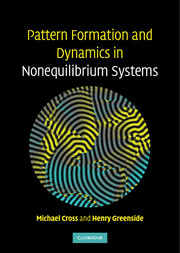Book contents
- Frontmatter
- Contents
- Preface
- 1 Introduction
- 2 Linear instability: basics
- 3 Linear instability: applications
- 4 Nonlinear states
- 5 Models
- 6 One-dimensional amplitude equation
- 7 Amplitude equations for two-dimensional patterns
- 8 Defects and fronts
- 9 Patterns far from threshold
- 10 Oscillatory patterns
- 11 Excitable media
- 12 Numerical methods
- Appendix 1 Elementary bifurcation theory
- Appendix 2 Multiple-scales perturbation theory
- Glossary
- References
- Index
Appendix 2 - Multiple-scales perturbation theory
Published online by Cambridge University Press: 05 August 2012
- Frontmatter
- Contents
- Preface
- 1 Introduction
- 2 Linear instability: basics
- 3 Linear instability: applications
- 4 Nonlinear states
- 5 Models
- 6 One-dimensional amplitude equation
- 7 Amplitude equations for two-dimensional patterns
- 8 Defects and fronts
- 9 Patterns far from threshold
- 10 Oscillatory patterns
- 11 Excitable media
- 12 Numerical methods
- Appendix 1 Elementary bifurcation theory
- Appendix 2 Multiple-scales perturbation theory
- Glossary
- References
- Index
Summary
This appendix describes and gives some examples of multiple scales perturbation theory. This is a widely used technique in applied mathematics, physics, engineering, and other fields that systematically yields approximate solutions to ordinary and partial differential equations for which there is a small parameter e such that the mathematical problem can be solved without too much effort when the small parameter is set to zero. In the context of pattern formation, the formalism provides a systematic way to analyze the spatiotemporal behavior of fields near the supercritical instability of a spatially uniform state. Near such a bifurcation, for reasons clarified by the multiple scales theory, the physical system can be accurately analyzed as a slowly varying spatiotemporal modulation of a fast oscillatory behavior in space or in time.
The perturbation theory is based on two key features. First is the idea of multiple scales, which is to introduce scaled space and time coordinates that capture the slow modulation of the pattern. These new scaled variables will be treated as mathematically independent of the original variables that are used to describe the pattern state itself. The second key feature is the use of what are known as solvability conditions. In the formalism, these conditions arise as mathematical statements that prevent a resonant driving of a higher-order term by a lower-order term that would cause the perturbation method to fail after a short time. The lowest-order nontrivial solvability condition often ends up being an evolution equation for a slowly varying multiplicative factor of the unperturbed solution, what we have called an amplitude equation.
Information
- Type
- Chapter
- Information
- Pattern Formation and Dynamics in Nonequilibrium Systems , pp. 503 - 519Publisher: Cambridge University PressPrint publication year: 2009
